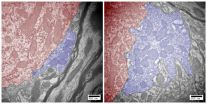(Press-News.org) Employing online training programs to teach psychotherapists how to use newer evidence-based treatments can be as successful as in-person instruction, according to a new RAND Corporation study.
Psychotherapy treatments can lag years behind what research has shown to be effective because there simply are not enough clinicians trained in new methods. That means that many people with mental health disorders are not getting the most effective nonpharmacological treatments, RAND researchers say.
For one such treatment, Interpersonal and Social Rhythm Therapy to treat bipolar disorder, a RAND study compared face-to-face training with online training and found e-learning to be as effective as traditional in-person instruction. In addition, e-learning enhanced clinician use of the skills just as well as traditional instruction, according to findings published online by the journal Psychiatric Services.
"Our findings suggest that e-learning can provide an efficient and scalable approach to training large numbers of clinicians in new evidence-based treatments," said Dr. Bradley D. Stein, the study's lead author, a practicing psychiatrist and a senior scientist at RAND, a nonprofit research organization. "This may be a way to improve patient care and solve the problem of how to get new treatments to the front-line mental health workforce."
Researchers worked with five community outpatient mental health centers and trained 36 clinicians, including social workers, licensed professional counselors, clinical psychologists and nurses, in Interpersonal and Social Rhythm Therapy to treat bipolar disorder.
The treatment approach emphasizes therapeutic techniques in interpersonal relations, as well as helping people with bipolar disorder maintain daily routines in order to help prevent exacerbation of symptoms.
In three of the mental health centers, clinicians received 12 hours of interactive online training at their convenience. They were supported by people from each clinic participating in a learning collaborative, who helped guide Interpersonal and Social Rhythm Therapy implementation through quality improvement efforts. Most clinicians had monthly hour-long telephone conferences with an expert in Interpersonal and Social Rhythm Therapy for the first three to six months following training.
Clinicians in the other two centers received traditional training consisting of a two-day, 12-hour in-person training led by Interpersonal and Social Rhythm Therapy developers. They received weekly on-site supervision of Interpersonal and Social Rhythm Therapy cases, and were encouraged to contact experts by phone or email with questions.
Researchers then asked 136 patients with bipolar disorder about their treatment from newly trained clinicians in all five mental health centers. Clinicians trained either way used the new techniques with patients equally. In addition, both groups of clinicians gradually increased their use of the evidence-based technique at six months and at a year after completing training.
"A goal of the trial was to do this in a way that would be easily replicated in real-world practice," Stein said. "The amount of time spent in training was the same in both the e-learning group and the face-to-face group. There could be some efficiency through e-learning savings in travel time and expenses for clinical staff or for trainers."
Because there are only a handful of people qualified to train clinicians in many new therapies, the task of getting tens of thousands of mental health practitioners up to speed on evidence-based therapies through traditional in-person training is a nearly impossible challenge, Stein said.
"We know that front-line mental health clinicians turn over at about the rate of 35 percent a year," Stein said. "That's where mental health centers have a problem. Do they bring in the expert again, or lose what they've gained from this new effective treatment model? By using online training, new clinicians can more easily get instruction."
INFORMATION:
Support for the study was provided by the National Institute of Mental Health and the Mueller Trust.
Other authors of the study are Karen L. Celedonia, Mark Sorbero, Rachel M. Burns and Andrew W. Dick of RAND; Dr. Holly A. Swartz and Ellen Frank of the University of Pittsburgh School of Medicine; Melissa DeRoseier of the 3C Institute; and Rayni A. Brindley of NHS Human Services.
RAND Health is the nation's largest independent health policy research program, with a broad research portfolio that focuses on health care costs, quality and public health preparedness, among other topics.
Tropical Storm Noul is still threatening Yap Island located in the Caroline Islands of the western Pacific Ocean, and a part of the Federated States of Micronesia. Micronesia has posted a typhoon warning for the tiny island. The storm is currently 22 miles south-southwest of Ulithi (one of the outer islands of the State of Yap) and is moving west at 2 knots per hour. Maximum sustained winds for the storm is 55 knots gusting to 70 knots and maximum wave height is 20 feet.
Noul is moving to the west and is expected to veer west northwest and later to the northwest. ...
After gobbling the fourth Oreo in a row while bathed in refrigerator light, have you ever thought, "That wasn't enough," and then proceeded to search for something more?
Researchers at BYU have shed new light on why you, your friends, neighbors and most everyone you know tend to snack at night: some areas of the brain don't get the same "food high" in the evening.
In a newly published study, exercise sciences professors and a neuroscientist at BYU used MRI to measure how people's brains respond to high- and low-calorie food images at different times of the day. The ...
Anxiety disorders affect approximately one in six adult Americans, according to the National Institute of Mental Health. The most well-known of these include panic disorder, post-traumatic stress disorder, obsessive-compulsive disorder, and social anxiety disorder. But what of brief bouts of anxiety caused by stressful social situations?
A new study by Tel Aviv University researchers, published recently in the Journal of Oral Rehabilitation, finds that anxiety experienced in social circumstances elevates the risk of bruxism - teeth grinding which causes tooth wear and ...
BUFFALO, N.Y. -- Cells that relay information from the ear to the brain can change in significant ways in response to the noise level in the environment.
That's one major finding of a study out today in the Early Edition of the Proceedings of the National Academy of Sciences.
Expose the cells to loud sounds for a prolonged period of time, and they alter their behavior and even their structure in a manner that may aid hearing in the midst of noise. End the ruckus, and the cells change again to accommodate for quieter environs.
"The brain is amazingly adaptable: The ...
A multidisciplinary team of Johns Hopkins researchers has developed two new strategies to treat depression in young people using the selective serotonin reuptake inhibitor (SSRI) class of medications. These strategies, published May 5 in the journal Translational Psychiatry, incorporate a new understanding of how to mitigate the risk of suicide while on SSRI treatment.
"These medications have to be dosed in a careful way," says senior investigator Adam Kaplin, M.D., Ph.D., an assistant professor of psychiatry and neurology at the Johns Hopkins University School of Medicine. ...
(Winston-Salem, N.C. - May 5, 2015) - Researchers from Wake Forest University and the University of Utah are the first to successfully fabricate halide organic-inorganic hybrid perovskite field-effect transistors and measure their electrical characteristics at room temperature.
"We designed the structure of these field-effect transistors that allowed us to achieve electrostatic gating of these materials and determine directly their electrical properties," said lead author, Oana Jurchescu, an assistant professor of physics at Wake Forest. "Then we fabricated these transistors ...
HOUSTON -- ( May 5, 2015 ) -- The effectiveness of cancer vaccines could be dramatically boosted by first loading the cancer antigens into silicon microparticles, report scientists from Houston Methodist and two other institutions in an upcoming Cell Reports (early online).
Model studies showed that microparticles loaded with an antigen, HER2, not only protected the antigen from premature destruction, but also stimulated the immune system to recognize and relentlessly attack cancer cells overexpressing the HER2 antigen.
"We could completely inhibit tumor growth after ...
An intervention to connect low-income uninsured and Medicaid patients to a reliable source of primary health care shows promise for reducing avoidable use of hospital emergency departments in Maryland. A University of Maryland School of Public Health study evaluating the results of the intervention was published this week in the May issue of the journal Health Affairs.
For twenty years, use of hospital emergency departments has been on the rise in the United States, particularly among low-income patients who face barriers to accessing health care outside of hospitals ...
The rainfall accumulation analysis above was computed from data generated by the Integrated Multi-satellite Retrievals for GPM (IMERG) during the period from April 28 to May 3, 2015. During this period IMERG algorithms continuously merged and interpolated satellite passive microwave precipitation estimates and microwave-calibrated infrared (IR) satellite estimates over the entire globe.
Rainfall from cyclone Quang fell over the west coast and a non-tropical system pounded the east coast of Australia simultaneously during the past weekend. Cyclone Quang formed in the South ...
A pilot study has found that participating in a nine-week training program including elicitation of the relaxation response had a significant impact on clinical symptoms of the gastrointestinal disorders irritable bowel syndrome and inflammatory bowel disease and on the expression of genes related to inflammation and the body's response to stress. The report from investigators at the Benson-Henry Institute at Massachusetts General Hospital (MGH) and at Beth Israel Deaconess Medical Center (BIDMC), published in the open-access journal PLOS ONE, is the first to study the ...



